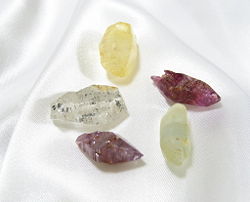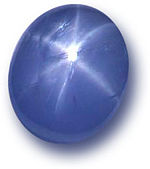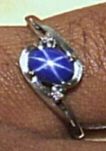Sapphire
- For other uses, see Sapphire (disambiguation).
| Sapphire | |
|---|---|
 |
|
| General | |
| Category | Mineral |
| Chemical formula | aluminium oxide, Al2O3 |
| Identification | |
| Color | Blue, pink, yellow, green, white, and parti-colour |
| Crystal habit | massive and granular |
| Crystal system | Trigonal |
| Cleavage | None |
| Fracture | Conchoidal, splintery |
| Mohs Scale hardness | 9.0 |
| Luster | Vitreous |
| Refractive index | 1.762-1.778 |
| Pleochroism | Strong |
| Streak | White |
| Specific gravity | 3.95-4.03 |
| Fusibility | infusible |
| Solubility | insoluble |
| Major varieties | |
| Ruby | When contaminated with chromium |
Sapphire (from Hebrew: ספּיר Sapir) is the single-crystal form of aluminium oxide (Al2O3), a mineral known as corundum. It can be found naturally as gemstones or manufactured in large crystal boules for a variety of applications.
The corundum group consists of pure aluminium oxide. Trace amounts of other elements such as iron and chromium give sapphires their blue, red, yellow, pink, purple, orange or greenish color. Sapphire includes any gemstone quality varieties of the mineral corundum including the red variety, which is also known as ruby.
Sapphires in nature
Blue sapphires come in a wide range of hues. Titanium and iron inclusions within the aluminium oxide result in various shades of blue. Some stones are not well saturated and show tones of gray. It is common to bake natural sapphires to improve color. This is usually done by heating the sapphires to temperatures of up to 1800°C for several hours, or by heating in a nitrogen deficient atmosphere oven for 7 days or more. On magnification the silk due to included rutile needles are visible. If the needles are unbroken, then the stone was not heated. If the silk is not visible then the stone was heated adequately. If the silk is partially broken then a process known as low tube heat was used. Low tube heat is the process where the rough stone is heated to 1300 °C for 20 to 30 minutes over charcoal. This takes out any gray or brown in the stone and improves color saturation.
Fancy sapphires are any sapphire other than blue or red. Purple sapphires are lower in price than blue ones. These stones contain the trace element vanadium and come in a wide variety of shades. Yellow and green sapphires have traces of iron which gives them their color. Pink sapphires are have trace element of chromium and the deeper the color pink the higher the value as long as the color is going toward red of rubies. Color shift sapphires are blue in outdoor light and purple in indoor light. Colour changes may also be pink in daylight to greenish in fluorescent light. Some stones shift color well and others only partially, in that some stones go from blue to blue purple. White sapphires usually come out of the ground as light gray or brown and are then heated to make them clear. However in very rare circumstances they will be found in a clear state.
Sapphires are mined from alluvial deposits or from primary underground workings. Historically, most sapphires have been mined in Sri Lanka, Madagascar and Myanmar. Australia leads the world in sapphire production (as of 1987) specifically from basalt derived placer deposits in Queensland and New South Wales. Pakistan, Afghanistan, India, Tanzania and Kenya also produce sapphires. The US state of Montana has produced sapphires from the Yogo Gulch deposit near Helena. Gem grade sapphires and rubies are also found in and around Franklin, North Carolina, USA. Several mines which are open to the public.
Synthetic sapphire for non-gemstone applications
Synthetic sapphire crystals can be grown in cylindrical crystal ingots of large size, up to many inches in diameter. As well as gemstone applications there are many other uses:
The first ever laser produced was based on the ruby chromium impurity in sapphire. While this laser has few applications, the Ti-sapphire laser is popular due to the relatively rare ability to tune the laser wavelength in the red-to-near infrared region of the electromagnetic spectrum. It can also be easily modelocked. In these lasers, a synthetically produced sapphire crystal with chromium or titanium impurities is irradiated with intense light from a special lamp, or another laser, to create stimulated emission.
Pure sapphire ingots can be sliced into wafers and polished to form transparent crystal slices. Such slices are used as watch faces in high quality watches, as the material's exceptional hardness makes the face almost impossible to scratch. Since sapphire ranks a 9 on the Mohs Scale, owners of such watches should still be careful to avoid exposure to diamond jewelry, and should avoid striking their watches against artificial stone and simulated stone surfaces. Such surfaces often contain materials including silicon carbide, which, like diamond, are harder than sapphire and thus capable of causing scratches (Scheel 2003).
Wafers of single crystal sapphire are also used in the semiconductor industry as a substrate for the growth of gallium nitride based devices.
Star Sapphire
A star sapphire is a type of sapphire that exhibits a star-like phenomenon known as asterism. Star sapphires contain intersecting needle-like inclusions (often the mineral rutile) that cause the appearance of a six-rayed 'star'-shaped pattern when viewed with a single overhead light source. Twelve-ray stars are also found, but are less common.
The value of a Star Sapphire depends not only on the carat weight of the stone but also the body color, visibility, and intensity of the star. Some sapphires are heat-treated or otherwise enhanced to improve their appearance and color, though some people object to such practices and prefer natural untreated stones. Treated stones tend to be darker than untreated stones and the treatment process causes changes to the internal structure that are generally easily detected.
Historical and cultural references
- According to Rebbenu Bachya, the word "Sapir" in the verse Exodus 28:20 means "Sapphire" and was the stone on the Ephod representing the tribe of Issachar. However, this is disputed as the sapphire of the Bible was likely lapis lazuli (Texas Natural Science Center, 2006).
- Supernatural powers were attributed to gems in India. One way this was manifested was the interdependence between gems and planets. Ruby, associated with the Sun, was the Lord of Gems, for the Sun lorded over all the planets. Blue sapphire is associated with Saturn (Wojtilla, 1973), yellow sapphire with Jupiter.
- Blue sapphires were first discovered in the Padar region of Kashmir in the 1880s, allegedly where a landslip had uncovered their occurrence. Kashmir stones were in most cases exceptionally fine quality. Stones from Madagascar are very often described to look like Kashmir quality.
- Sapphire is the birthstone associated with September.
- The 45th wedding anniversary is known as the sapphire anniversary.
ReferencesISBN links support NWE through referral fees
- Scheel, Hans J. and Tsuguo Fukuda, Eds, 2003, Crystal Growth Technology, John Wiley & Sons ISBN 0-471-49059-8 (Available as PDF
- Sofianides, Anna S. and George E. Harlow, 1997, Gems & Crystals, Parkgate Books, pp. 44-55 ISBN 1-85585-391-4
- Texas Natural Science Center, Mineral Lore and Mythology, 2006
- Mindat with location data
- Wojtilla, G. Indian precious stones in the ancient East and West, Acta Orientakia (Budapest) 27, 2, 211-224.
bg:Сапфир da:Safir de:Saphir et:Safiir es:Zafiro fr:Saphir it:Zaffiro he:ספיר lv:Safīrs lt:Safyras nl:Saffier ja:サファイア no:Safir ug:كۆك ياقۇت pl:Szafir pt:Safira ro:Safir ru:Сапфир sl:Safir fi:Safiiri sv:Safir tr:Safir zh:蓝宝石

